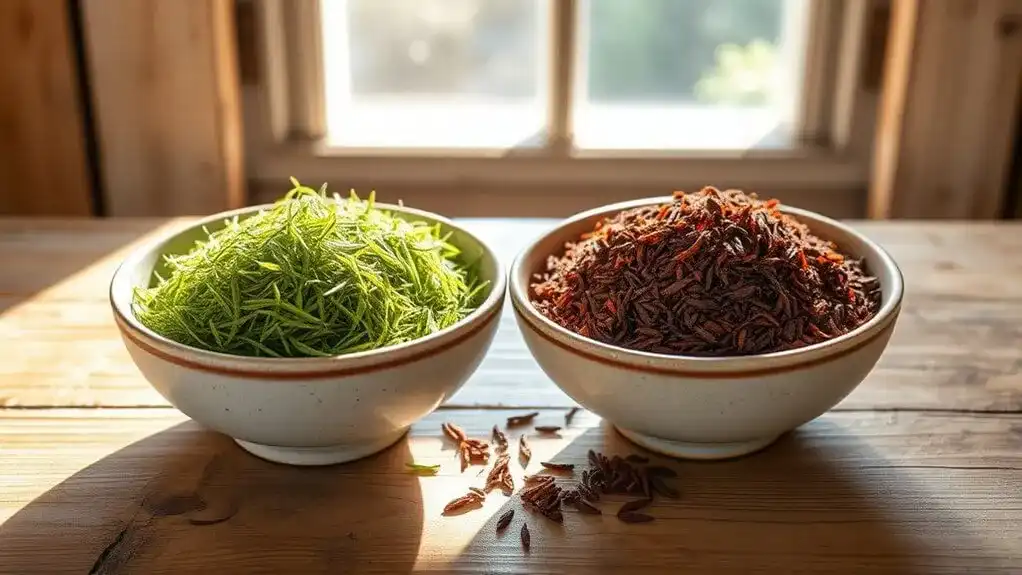The primary distinction between green and red rooibos lies in their processing methods after harvest. Red rooibos undergoes oxidation through bruising and rolling, developing its signature reddish-brown color and rich flavor profile. In contrast, green rooibos is immediately steamed and dried to prevent oxidation, preserving its natural state and higher antioxidant content. This fundamental difference in processing affects not only the tea's appearance and taste but also its nutritional benefits, making each variety uniquely appealing.
Key Points
- Red rooibos undergoes oxidation through bruising and rolling, while green rooibos is immediately steamed to prevent oxidation.
- Green rooibos maintains higher antioxidant and polyphenol levels due to minimal processing after harvesting.
- The oxidation process gives red rooibos its characteristic reddish-brown color, while green rooibos maintains a lighter orange hue.
- Red rooibos develops a rich, full-bodied flavor through oxidation, whereas green rooibos exhibits a more natural, grassy taste.
- Both varieties start from the same plant, but their distinct processing methods create different nutritional profiles and taste characteristics.
From Plant to Process: The Journey of Rooibos Tea

The journey of rooibos tea begins in South Africa's pristine Cederberg region, where the distinctive plant thrives in its native soil. Plant cultivation starts with seeding between February and March, followed by a careful transplanting process. The plants require 18 months of growth before their first harvest, making the most of winter rains and spring's mild temperatures. The plant's remarkable adaptation to the region includes deep root systems that efficiently utilize available water resources.
The harvesting techniques involve skilled workers who hand-cut mature branches using sickles, typically from December to March. They bundle the cut branches into "gerwe," weighing 10-15 kg each, before transporting them to processing facilities. During the early spring harvest, workers focus on cutting only the longest stems, which promotes bushier growth. This precise approach to harvesting guarantees the plant's sustainability and peak tea quality. After harvesting, the cut rooibos undergoes enzymatic oxidation processes that transform its color from green to the characteristic red-amber shade. The traditional processing method includes a hot air drying step that specifically prevents oxidation when producing green rooibos tea.
The Art of Oxidation: What Makes Red Rooibos Red
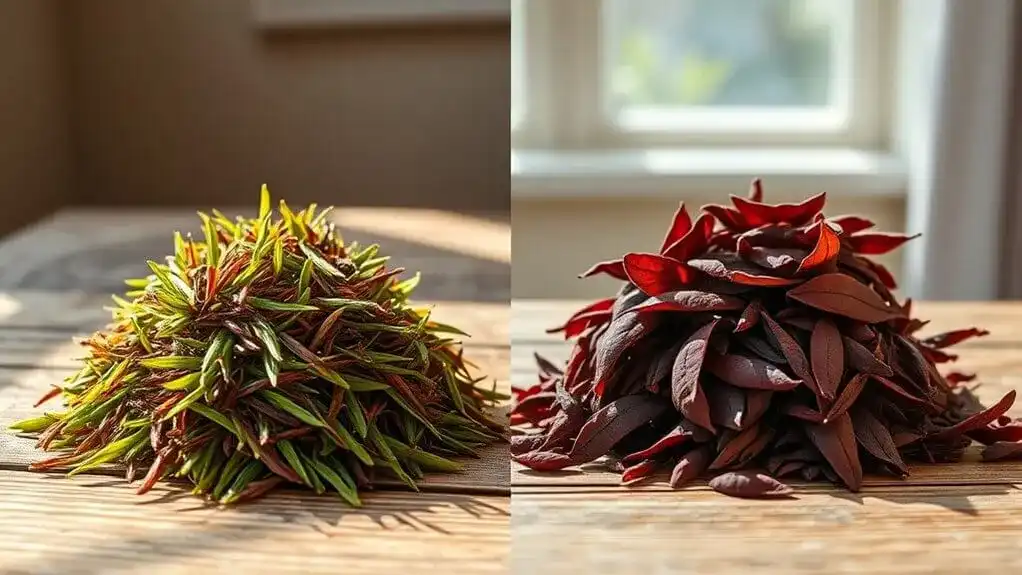
Once harvested rooibos leaves arrive at processing facilities, they begin their remarkable transformation from green to red through oxidation. The process involves specific oxidation techniques where workers bruise and roll the leaves, triggering enzymatic changes that develop the tea's flavor complexities. This controlled oxidation, similar to black tea production, allows the leaves to mature and ferment, creating the distinctive red-brown color that gives red rooibos its name. Just as with traditional tea processing, the exposure to oxygen immediately begins changing the chemical composition of the leaves after harvesting. Originally discovered by the Khoisan people of South Africa, this oxidation process has been refined over centuries of traditional practice.
Key aspects of the oxidation process include:
- Bruising and rolling leaves to initiate oxidation
- Exposure to oxygen for color development
- Enzymatic changes that mature polyphenols
- Fermentation for flavor enhancement
- Careful monitoring of the oxidation process
Unlike its green counterpart, red rooibos undergoes complete oxidation, which creates its unique characteristics and rich flavor profile.
Green Rooibos: The Unoxidized Alternative
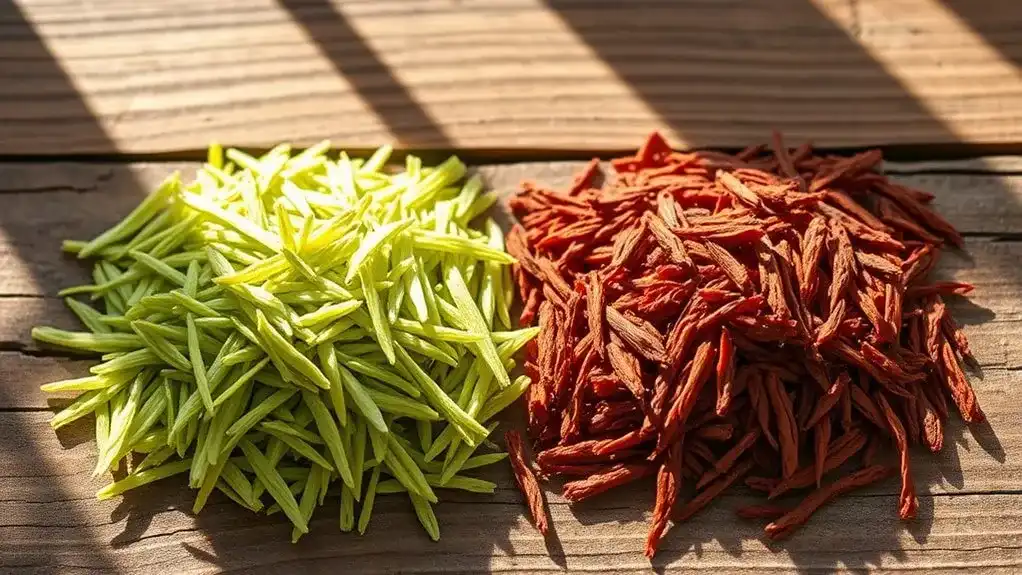
Unlike its oxidized counterpart, green rooibos undergoes a distinctly different processing method that preserves its natural state and higher antioxidant content. The preparation involves immediately steaming and drying the leaves after harvesting, effectively halting the oxidation process. First used by the Sans people, this herbal tea has a rich history of medicinal use in South Africa.
This unique method of processing results in several green rooibos benefits, including enhanced polyphenol levels and a distinctive grassy flavor profile. Hot air drying helps create a light orange infusion. While less common than its red cousin, green rooibos offers higher antioxidant content, which may boost immune function and aid in disease prevention. It's particularly appealing for those seeking a caffeine-free alternative that can be enjoyed at any time of day. Like red rooibos, it supports weight management with its low calorie content and may contribute to skin health through its antioxidant properties. The tea's alpha hydroxy acid content makes it especially beneficial for improving the appearance of fine lines and wrinkles.
Processing Methods That Shape Flavor and Color
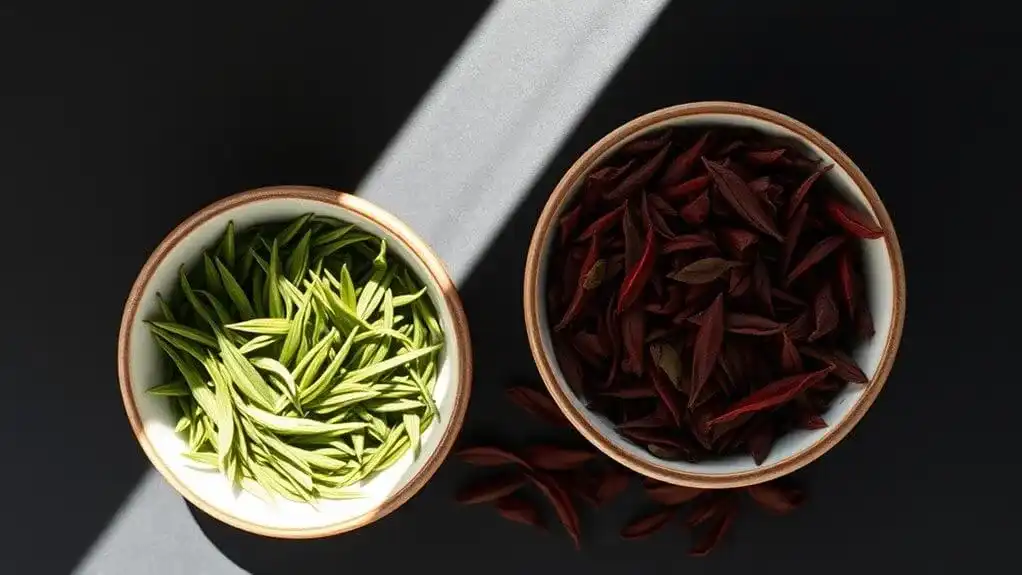
Processing techniques play a pivotal role in determining rooibos tea's final flavor profile and signature color characteristics. The oxidation impact creates distinct differences between red and green varieties, with red rooibos undergoing a longer fermentation process that develops its rich, sweet taste and reddish-brown hue. Green rooibos, dried immediately after harvest, maintains its natural color and delivers a lighter, more delicate flavor.
Key factors that influence the final product's characteristics:
- Harvest timing in Southern Hemisphere summer affects initial quality
- Cutting precision determines tea bag versus loose leaf preparation
- Moisture and temperature control during processing impacts flavor development
- Oxidation duration directly correlates with color intensity
- Processing method choice (immediate drying vs. oxidation) determines phenolic content
The careful management of these variables guarantees consistent quality and desired flavor outcomes in both varieties.
Health Benefits: How Processing Affects Nutrients
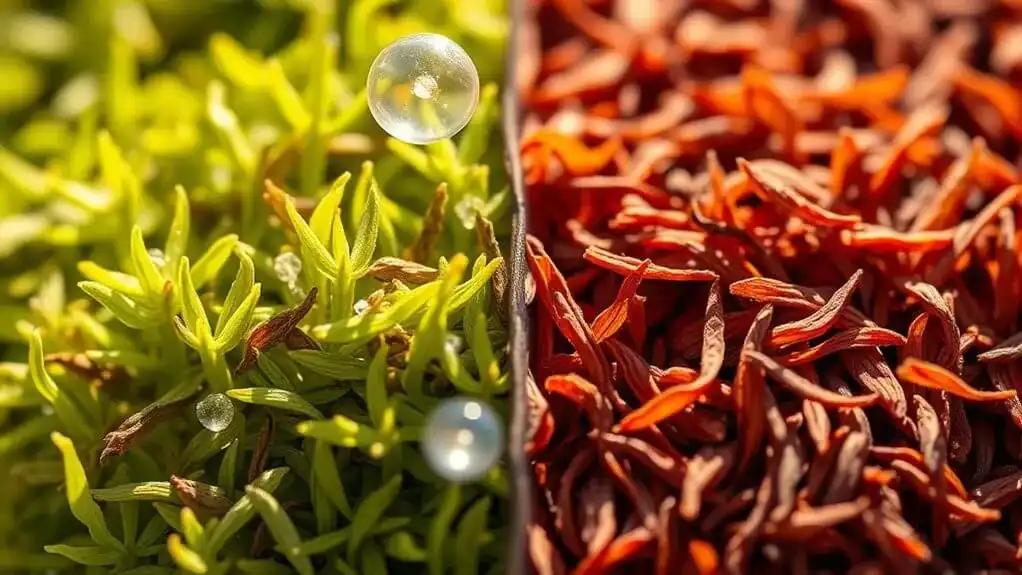
The varying levels of heat and oxidation during rooibos processing directly influence its nutritional composition. Green rooibos, which undergoes minimal processing, demonstrates superior nutrient retention, particularly in its polyphenol content and antioxidant levels. It contains higher concentrations of the beneficial compound aspalathin and shows greater antimutagenic properties in laboratory studies. The tea's potent anti-inflammatory effects have been shown to prevent obesity-related health issues. Both varieties being completely caffeine free makes them excellent alternatives to traditional teas and coffee at any time of day.
Red rooibos, despite experiencing more extensive oxidation, maintains unique health advantages. The fermentation process enhances its ability to support bone health through osteoclast inhibition and promotes cardiovascular wellness by improving blood pressure and cholesterol levels. Both varieties share important benefits, including blood sugar regulation and cancer-fighting properties. They're equally effective at increasing antioxidant capacity in human blood, though green rooibos typically maintains higher overall antioxidant concentrations due to its gentler processing method.
Conclusion
While both green and red rooibos come from the same plant, it's their processing journey that creates two distinct teas. Coincidentally, like its distant cousin green tea, green rooibos maintains higher antioxidant levels through minimal oxidation. Whether you're sipping the traditional red's sweet, nutty profile or the green's grassier notes, you'll find nature's remarkable ability to produce different flavors through simple processing variations.
